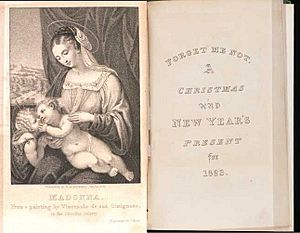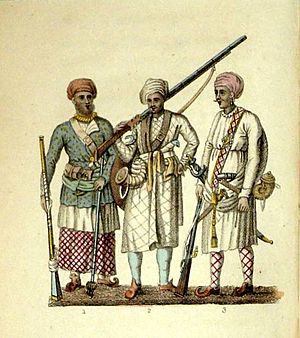Frederic Shoberl facts for kids
Quick facts for kids
Frederic Shoberl
|
|
|---|---|
| Born | 1775 London, England
|
| Died | 1853 |
| Other names | Frederick Shoberl |
| Known for | Editor, writer |
| Children | Two |
Frederic Shoberl (born 1775, died 1853) was an English journalist, editor, translator, writer, and illustrator. He was also known as Frederick Schoberl. He is famous for editing Forget-Me-Not. This was the very first literary annual in England, released around Christmas in 1823. He also translated the famous book The Hunchback of Notre Dame.
Contents
About Frederic Shoberl
Frederic Shoberl was born in London in 1775. He went to school at the Moravian school in the Fulneck Moravian Settlement in West Yorkshire.
In 1809, he started editing Repository of Arts for Rudolph Ackermann. This magazine was quite new at the time. Ackermann was known for making aquatint engraving popular. His Repository of Arts covered many topics. These included "arts, literature, commerce, manufactures, fashions, and politics."
In February 1814, Shoberl and Henry Colburn started The New Monthly Magazine together. They were co-owners. For some time, Shoberl was the editor. He wrote many articles and reviews for this magazine. He also continued to edit Ackermann's magazine.
From 1818 to 1819, he worked as a printer and publisher. He worked for the Cornwall Gazette, Falmouth Packet, and Plymouth Journal. The last one was published in Truro in Cornwall.
Starting the Forget-Me-Not Annual
In 1822, Shoberl became the first editor of Ackermann's Forget-Me-Not. This was a new type of publication in England called an annual. It was the first literary annual published in English. Shoberl continued to edit this annual until 1834. He also started looking after Ackermann's younger annual. This was called The Juvenile Forget-Me-Not, from 1828 to 1832.
Besides his editing work, Shoberl was also an illustrator. He made his own hand-coloured pictures for The World in Miniature: Hindoostan. This book was published in London by Ackermann in the 1820s.
Family Life and Death
Frederic Shoberl married a woman named Theodosia. They had two sons. Their son William worked as an assistant to Henry Colburn. Later, he became a publisher. Their other son, Frederic, was a printer for Prince Albert. He died a year before his father. Shoberl's wife, Theodosia, passed away in December 1838.
Frederic Shoberl died in Brompton, London, on March 5, 1853. He was buried in Kensal Green cemetery a week later.
Shoberl's Lasting Impact
Frederic Shoberl's work as an editor is still important today. The Forget-Me-Not publications are being put online. This is because they are very valuable. They include poems by famous writers like Hester Thrale, Sir Walter Scott, and Mary Wollstonecraft. The artwork from these publications has also been put online.
It was the editor's job to find and borrow artwork for the magazine. Many of the artists chosen were from the Royal Academy of Arts. The editor had to agree on a price to use their art. Once the artwork was engraved, it was then used to inspire new stories and poems for the magazine.
Selected Works
Here are some of the books and works Frederic Shoberl was involved with:
- 1812 – A topographical and historical description of the county of Surrey
- 1814 – Narrative of the Most Remarkable Events Which Occurred in and Near Leipzig...14 to 19 October 1813 (He translated this from German)
- 1816 – A biographical dictionary of the living authors of Great Britain and Ireland (with John Watkins and William Upcott)
- 1816 – A historical account, interspersed with biographical anecdotes, of the house of Saxony
- 1818 – Suffolk; or, Original delineations, Typographical, Historical, and Descriptive, of that County.
- 1821 – The World in Miniature
- 1822 – Forget-Me-Not
- 1824 – Translation of Friedrich Adolf Krummacher: Parables; by F. A. K.
- 1828 – Persia
- 1828 – Austria; containing a description of the manners, customs, character and costumes of the people of that empire
- 1829 – Turkey, being a description of the manners, customs, dresses and other peculiarities characteristic of the inhabitants.
- 1833 – The Hunchback of Notre-Dame (He translated this just two years after the French version came out)
- 1839 – The Language of Flowers.
- 1840 – Lights and Shades of Military Life, a translation of Alfred de Vigny's Servitude et grandeur militaires.
- 1843 – Frederick the Great, his court and times (with Thomas Campbell)



